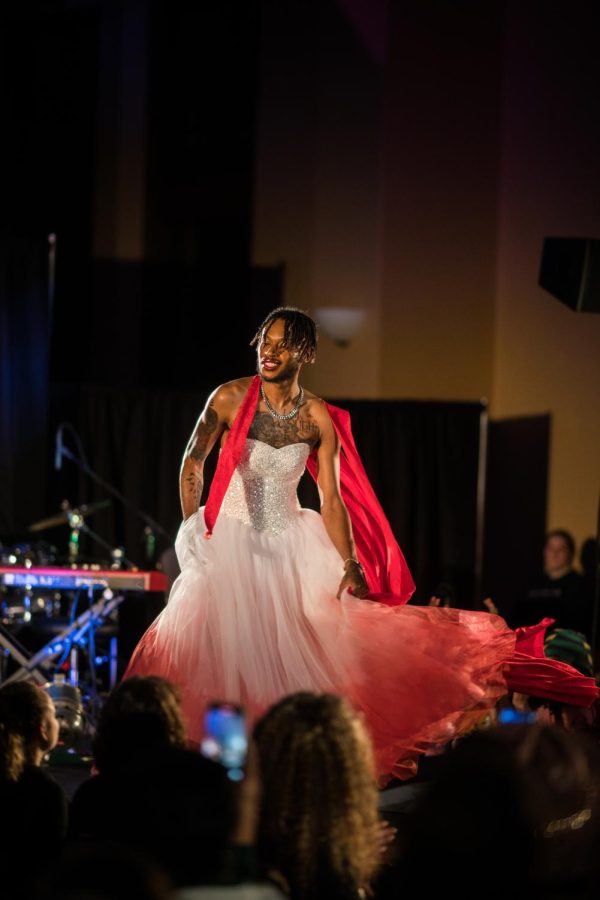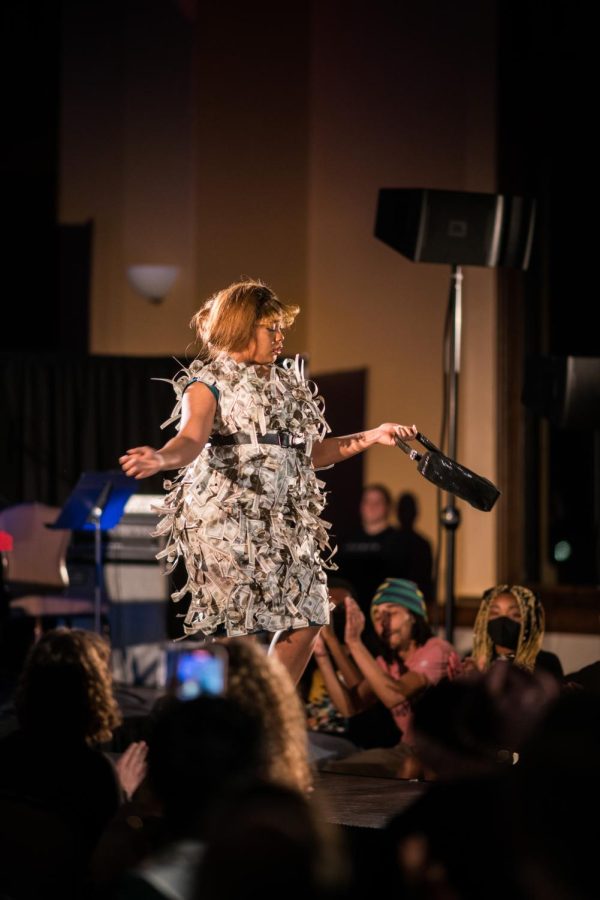Black History Month Fashion Show Promotes Sustainability and Thrifting
Models posed in fashion show wearing designs crafted by students using sustainable clothing and resources.
The annual Black History Month fashion show may have only begun in 2018, but it has quickly become one of Oberlin’s most popular events. This year, the Root Room in Carnegie Building was packed to the brim and ablaze with movement, immaculate looks, and music for the show’s hour-and-a-half-long duration, which passed by in the blink of an eye. Even the intermission had the audience swaying and hooting; the Oberlin College Black Musicians’ Guild graced the stage with a powerful live band and set list. The show began with a student performance: College fourth-year Reggie Goudeau laid down a trifecta of original tracks to set the show’s tone. The show’s DJ, Diwe Augustin-Glave, OC ’22, announced the theme of the show: “Woven, Worn, and Reborn: A Sustainable Black Fashion Show.”
The event was organized in partnership with the Green EDGE Fund. The show exemplified sustainability through various innovative angles, including pieces repurposed from last year’s show, thrifted items, and clothing made from unconventional items such as beauty blenders and trash bags. Audience members left the show inspired by its imaginative inventions. Though each look represented months of the Black History Month Fashion Board’s ongoing work, many were contributions of student designers working to the last minute to make sure everything was in place.
College fourth-year Divine McAllister has participated in the Black History Month fashion show all four years at Oberlin, but this was his first year as a designer. He created five pieces for the show in total, including the spectacular and memorable trash-rosette piece — a gown with a huge bell skirt made entirely from a box of Hefty bags — which he describes as “giving Ursula with roses.” He also designed a look that involved a very particular and meticulous piece of craftsmanship: the bottle cap vest, which he made by punching holes through each of the bottle caps with a piercing gun and sewing them to the back of the vest by hand. He drew inspiration from the line, “Anything but Fabric,” an original theme that spawned a host of striking and innovative looks from his fellow designers.
McAllister expressed how the BHM show provides an opportunity for designers and members to carry on and reimagine the work of designers from past shows and build connections within the Black community at Oberlin.
“I don’t think I was as connected to the Black community here at Oberlin before my first Black History month and Black History Month fashion show,” McAllister said. “I think the possibilities that the show allows [are endless]. What does it mean for a Black trans woman to put on a wedding dress and walk across that stage? Also, it gets to show parts of you that you didn’t think people would see. I don’t think I get to create as often as I’d like — there’s many parts of my style that I don’t get to express. It’s just always amazing seeing people stand differently, just [doing] something that they didn’t know that they might’ve needed.”
College fourth-year Kamcee Ugwokegbe crocheted a twopiece set in her first try at clothing crochet and, like McAllister, has been modeling in the show since her first year. She expressed that although this year’s thematic focus was on sustainability, “Woven Worn and Reborn” certainly isn’t the first BHM show to utilize sustainable practices.
“We had different meetings to try to throw out different ideas, and because we were collaborating with the Green EDGE Fund, we knew we wanted to do something that revolved around sustainability,” Ugwokegbe said. “In terms of the actual sustainable actions, we had a lot of stuff from the fashion shows before, and so we wanted to reuse that and also go thrifting and just see what people also had in their closets, just to make sure we weren’t buying as many things. I think every year, the fashion show definitely uses some element of sustainability, because they’re always using stuff in the shows before or using stuff from people’s closets.”
Students can look forward to next year’s Black History Month event and, in turn, recognize the culture and art that comes from the Oberlin Black community.












